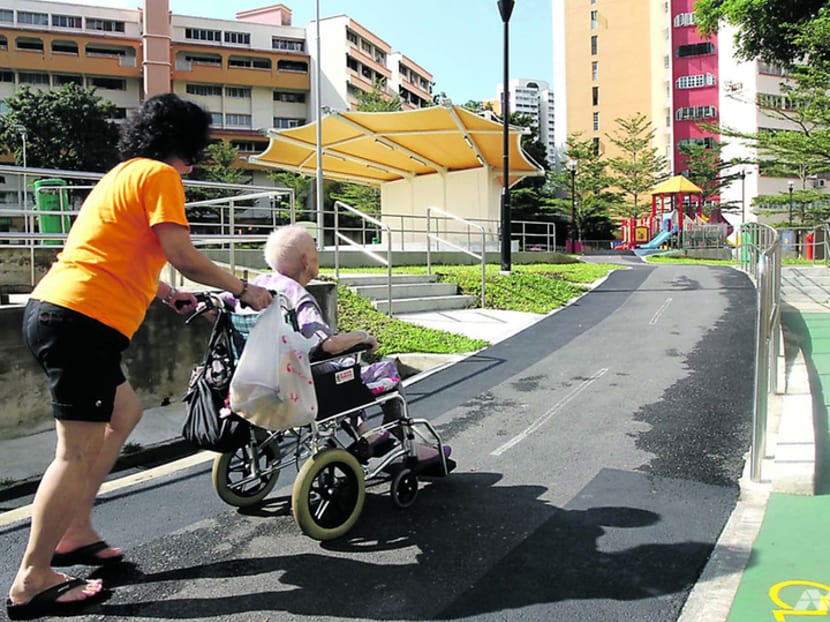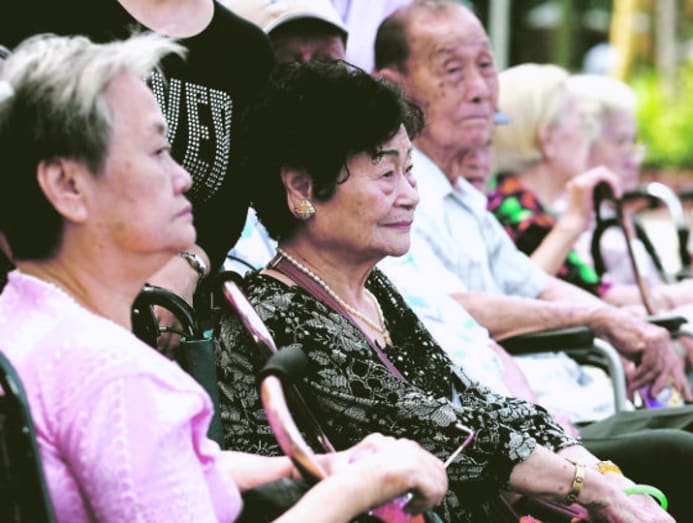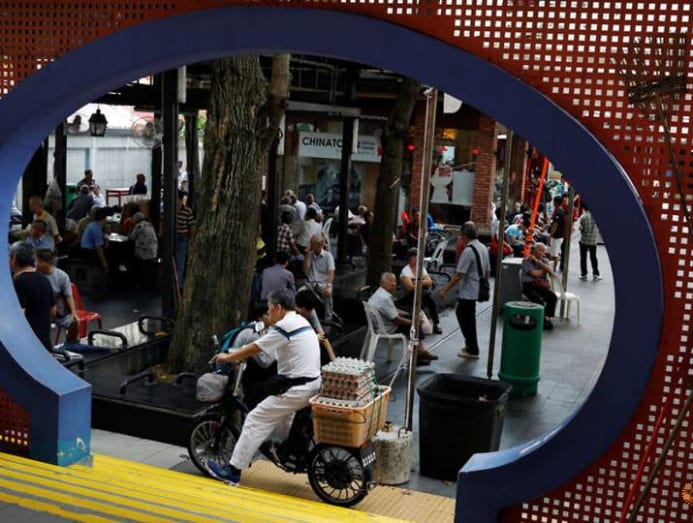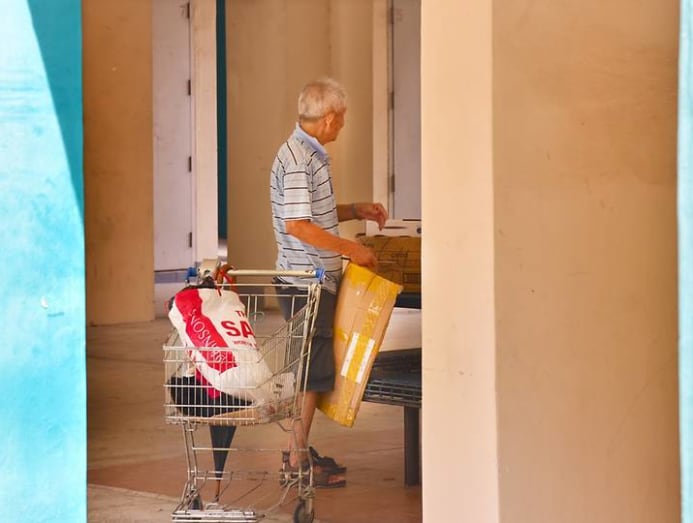commentary Commentary
Commentary: Three stories from caregivers show we still undervalue caregiving
We need a deeper conversation on how to support caregivers and provide them with the financial and psychological support they need, says Member of Parliament Anthea Ong.

An elderly woman in a wheelchair with her caregiver. (File photo: TODAY)
SINGAPORE It’s been said that there are four kinds of people in the world: Those who have been caregivers, those who are currently caregivers, those who will be caregivers, and those who will need a caregiver.
Indeed, I was recently at a corporate event and met a most unlikely caregiver — Siti, a young professional in her twenties who became emotional when sharing her challenges caring for her three unmarried aunts in their 60s — one suffering from diabetes and depression, another from ovarian cancer and the third from kidney failure.
Caregiving affects all of us yet this role is, ironically, one of the most undervalued in our society.
CHALLENGES OF INFORMAL CAREGIVING
The psychosocial well-being of caregivers must be top of mind for our caregiving policies. We have not done a comprehensive national study on caregiver health (which I highly recommend we do) but segmented studies have revealed that our caregiver population is certainly facing higher mental health risks.
Caregiving is stressful and can cause depression. Among caregivers of stroke survivors, 40.2 per cent have depressive symptoms, according to a 2017 study by the Institute of Mental Health and National University of Singapore.
Caregivers of cancer patients are also at greater risk of developing depression than the general population, a study in the Singapore Medical Journal also found.
READ: 'Smiling depression', depressed while appearing happy, a dangerous combination, a commentary
Wendy* is a caregiver involved in a study by the Association of Women for Action and Research (AWARE) on the financial costs of caregiving. She is 51, single, and a caregiver to her mother who has dementia.
While she has hired a foreign domestic worker, she remains the “emotional anchor” for her mother. Caregiving has taken a toll on Wendy emotionally, physically and financially — she’s had panic attacks and experiences high levels of anxiety.
Then there’s Ivan*, in his 50s, who’s struggling to cope with the severe care needs of his 85-year-old mother with dementia. Unable to deal with his mother’s mounting behaviour issues last year, he had a series of anxiety attacks and ended up in hospital himself.

READ: The role reversal between parent and child, as ageing takes a toll on families, a commentary
With smaller families, there are fewer family caregivers. Over the past few decades, however, Singaporeans have been fortunate to have an army of efficient, dedicated and relatively affordable foreign domestic workers. They form an important part of our informal care workforce.
Yet, the economic impact of caregiving on Singapore is obvious. The Labour Force Survey 2018 shows that 75,800 women and 13,000 men cite caregiving to families and relatives as the main reason for being out of the labour force. This number does not include caregivers who have had to scale back on work commitments in other ways, for example, by moving to part-time or ad-hoc work.
Wendy, whom I mentioned earlier, scaled down on her working hours and now earns less than S$2,000 a month, about one-fifth of what she used to earn. Ivan quit his job to look after his mother, after she repeatedly forgot to turn off the gas at home.
READ: Dementia caregivers put on a brave front – while watching loved ones fade away, a commentary
Another caregiver, June*, stopped working completely when her husband was diagnosed with Parkinson’s disease. She is 60 and the sole caregiver to her husband as they have no children. Their only monthly household income of S$1,000 comes from renting out a room in their HDB flat.
CHALLENGES IN FORMAL CARE SERVICES
Did these caregivers lessen their caregiving burden with formal care services?
Wendy tried daycare but her mother reacted violently against it. She’s now considering the nursing home option but the guilt is immense and she’s been putting it off despite her own deteriorating emotional and physical health. Then there’s the cost of the nursing home fee that she will struggle to afford with her drastically reduced income.
June’s husband goes to daycare but is guilt-ridden because he does not like it there yet she needs that time to go to the hospital for physiotherapy. June spends around S$300 to S$400 on daycare (after government subsidies) plus S$100 on transport to her husband’s daycare a month against her S$1,000 rental income.

READ: Caregivers are getting some support but deserve more care, a commentary
Most of us would like to be cared for in the comfort of our own homes. However, the increasingly complex care needs of our seniors and shrinking families must be balanced against the needs of the caregiver, meaning formal home-based and community care services are critical and practical necessities.
While the Government has been busy increasing capacity in recent years, more needs to be done to improve the affordability and quality of these services.
The ElderShield Review Committee report estimated that, including transport, consumables and formal home care services, it could cost caregivers as much as S$3,100 per month to look after a severely disabled senior at home, well above the S$2,400 median monthly fee for looking after severely-disabled residents in VWO-run nursing homes.
The Care Where You Are report by Lien Foundation notes that co-payment of care fees remains a key concern for families, although means-tested Government subsidies for long-term care have been increased to cover up to two-thirds of Singaporean households since 2012.
Even for those who are not severely disabled, daycare and home care services can cost S$900 to S$2,200 per month before subsidies, excluding transportation costs. Families eligible for subsidies must co-pay between 20 per cent and 70 per cent. Those with a per capita monthly household income of more than S$2,600 do not qualify for subsidies at all.
Costs may therefore deter even middle-income families from using formal long-term care services, especially since many find it cheaper to hire a foreign domestic worker instead.
However, foreign domestic workers — and even family caregivers themselves — may not be trained to handle complex care needs and, sometimes, could end up compromising the well-being and health of vulnerable seniors, leading to unnecessary hospital stays.
LISTEN: Why foreign domestic workers are borrowing money, an episode on The Pulse podcast
Home care is expensive too and appears underfunded with charity dollars, even after accounting for government subsidies and payouts from CareShield Life insurance — a scheme that may be useful but limited in its impact, given the strict qualifying conditions for payout and seeing that the scheme is optional for older cohorts who need long-term care now.

Even as we work out ways to improve affordability, emphasis must be made on quality and outcomes. In recent years, many sophisticated new care models - such as the Integrated Home and Daycare Programme - have sprung up.
Anecdotal evidence suggest these schemes fulfill some care gaps though programme outcomes need to be tracked and made public to convince skeptical caregivers of their effectiveness.
SHIFT HEALTHCARE SPENDING TOWARDS LONG-TERM AGED CARE
Singapore is ageing from a position of relative strength. We have a largely healthy population and there is a sharper focus in recent years on harnessing the potential benefits of longevity. Yet we must do more.
While the importance of enabling seniors to age at home is widely acknowledged, the Lien report also noted that Government spending on home-based and centre-based care — at S$240 million in 2016 — accounted for only 2.5 per cent of the overall S$9.8 billion healthcare budget for the year.
The Government should consider recalibrating the healthcare budget to enable seniors to age and be cared for at home. More subsidies can be targeted at seniors who are not severely disabled — and therefore do not qualify for ElderShield or CareShield Life — but likely to benefit from professional rehabilitative care before their conditions deteriorate further.
LISTEN: What life in your 60s should look like, an episode on The Pulse podcast
To better support caregivers’ psychosocial well-being needs, the Government could consider giving seniors flexible care packages, whether for daycare, home care, respite care services, transport fees and consumables, or to pay a family member or friend for elder-sitting. Respite care should be enhanced to include counselling and self-care training services as well.
Another way forward is to accord the long overdue recognition and appreciation to family caregivers with an allowance or payment, in both cash and CPF credits. This also ensures some level of financial security for them.
The recent announcement of the S$200 home caregiving grant that replaces the S$120 foreign domestic worker grant is a step in the right direction but it is arguable whether the amount is sufficient.
Perhaps, the payment should vary by the number of Activities of Daily Living the care recipient requires assistance with.

To enable caregivers to continue working while providing care, the Government should consider converting paid childcare leave into a longer quantum of family care leave of at least 10 days and allow it to be used for the care of any family members, including older relatives. Employers should be partners in this effort to provide flexible work arrangements on request by employees.
Above all, we should collectively embrace caregiving — not as the burden of a few, but a responsibility of all.
There is an urgent need for more informed collective conversations among Singaporeans about what kind of care system we want for our grandparents, parents — and eventually ourselves — and how much we are willing to pay for it, whether through premiums or taxes, for those who can afford it and to support those who cannot.
Because to care for those who once cared for us is one of life’s greatest honours.
Anthea Ong is Nominated Member of Parliament, Hush Teabar founder and author of 50 Shades of Love who advocates for mental health, diversity and inclusion of vulnerable communities, volunteerism and environmental issues.





